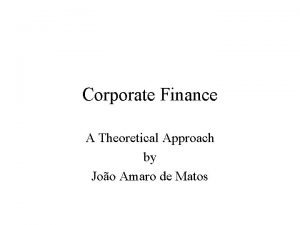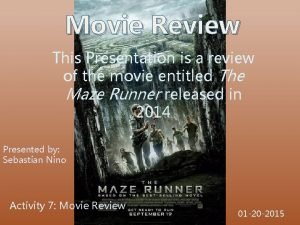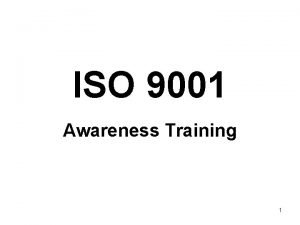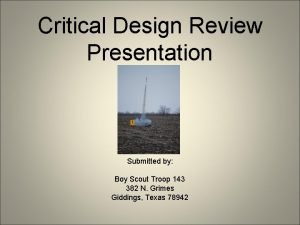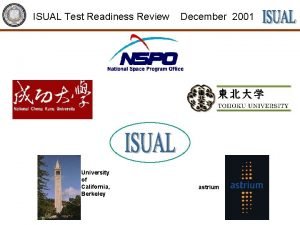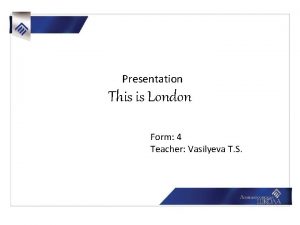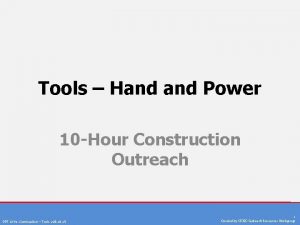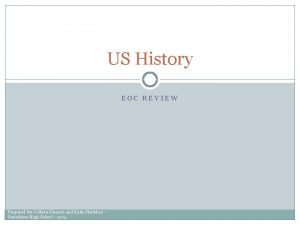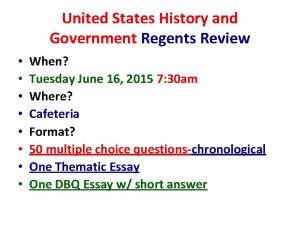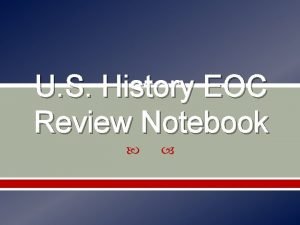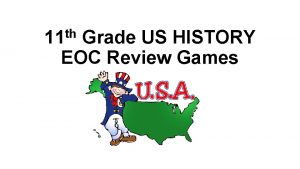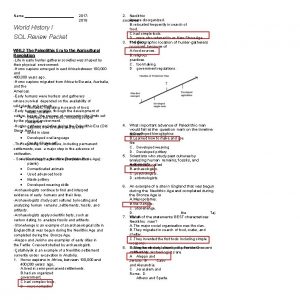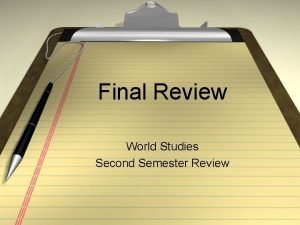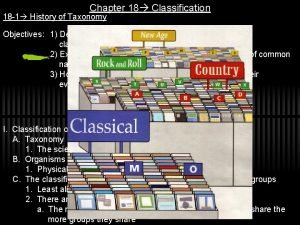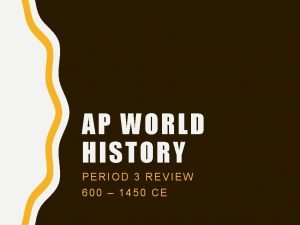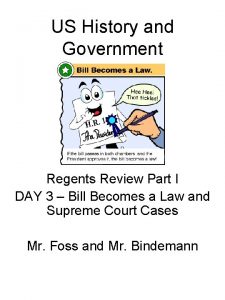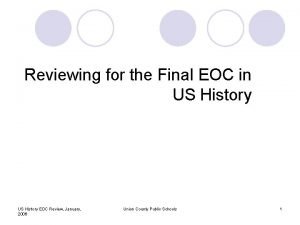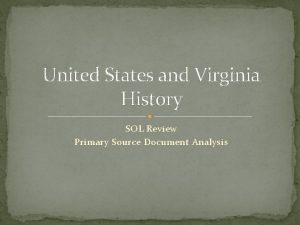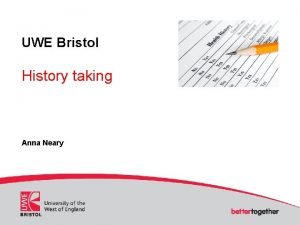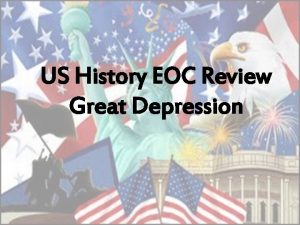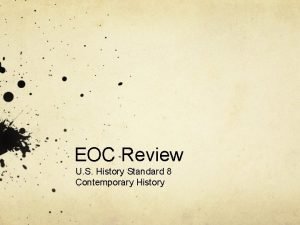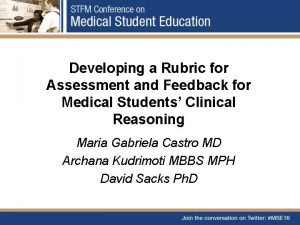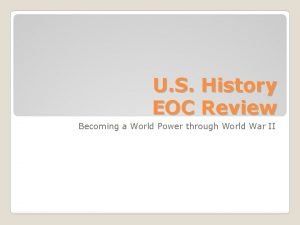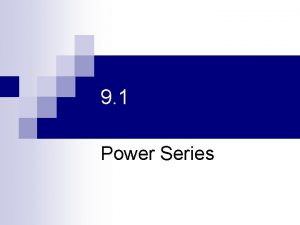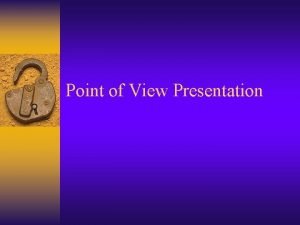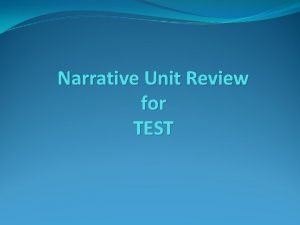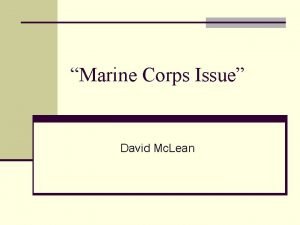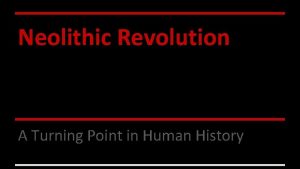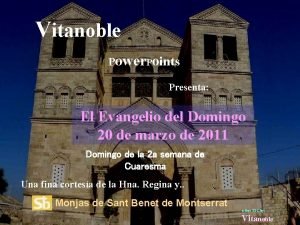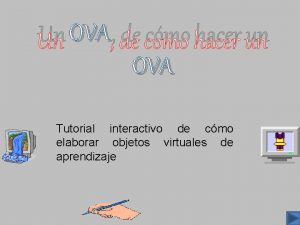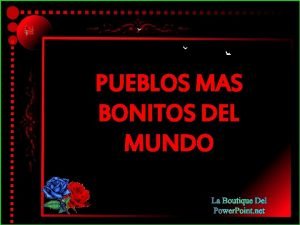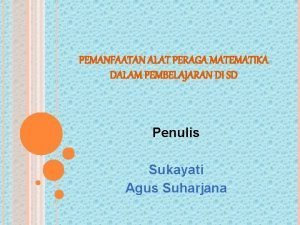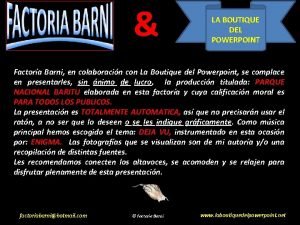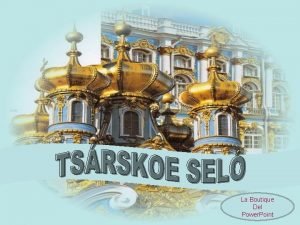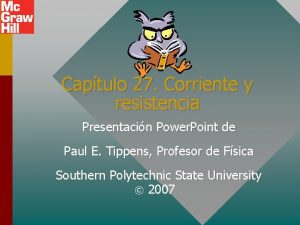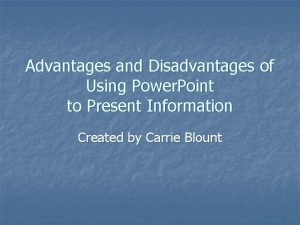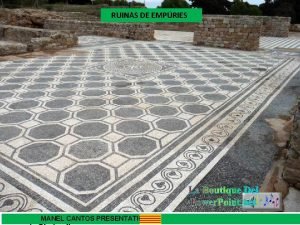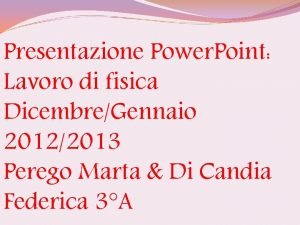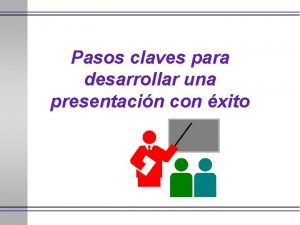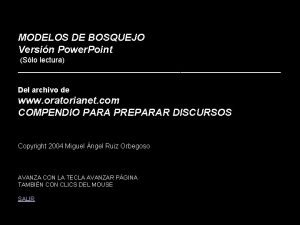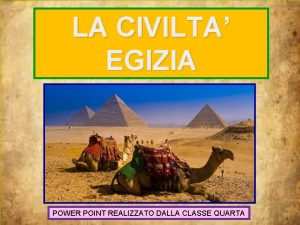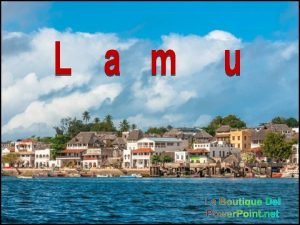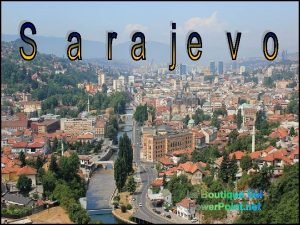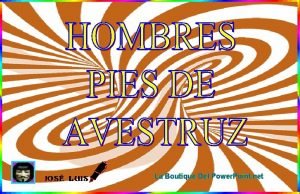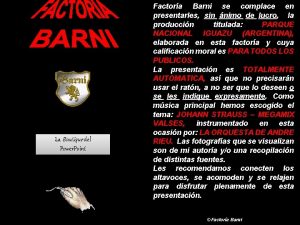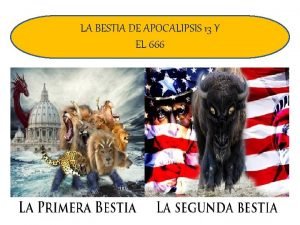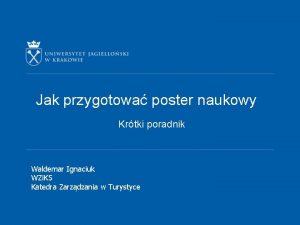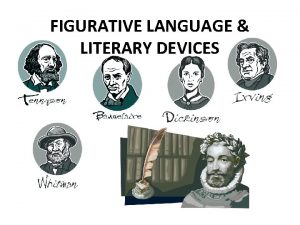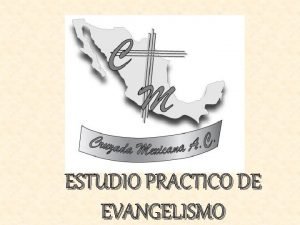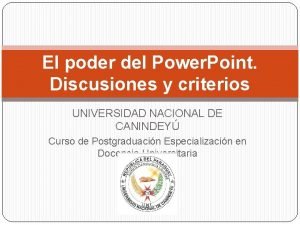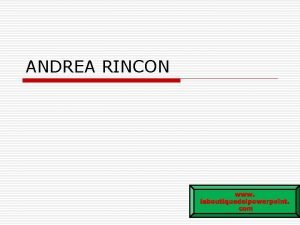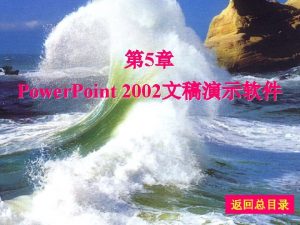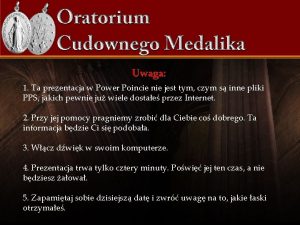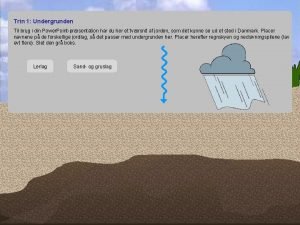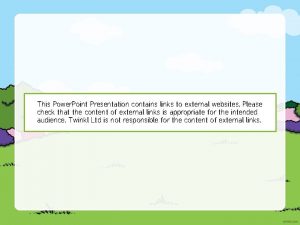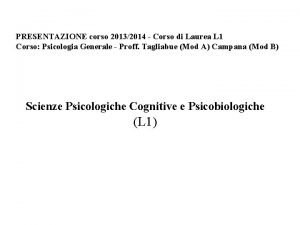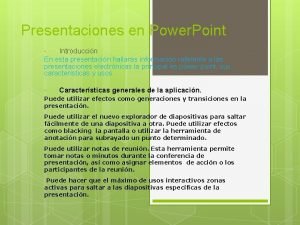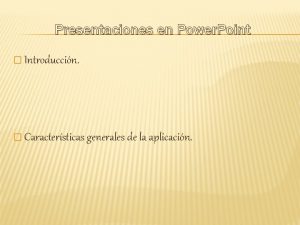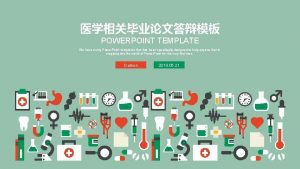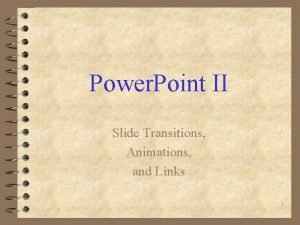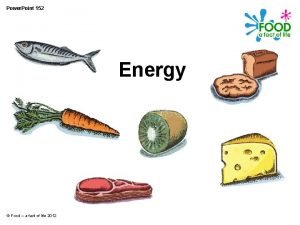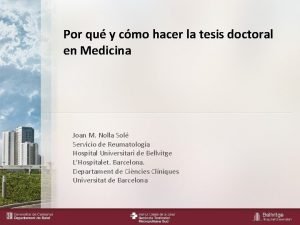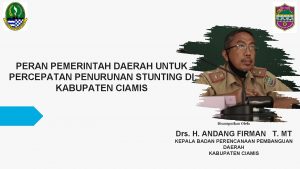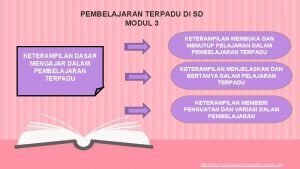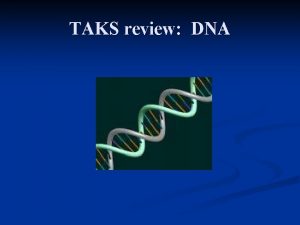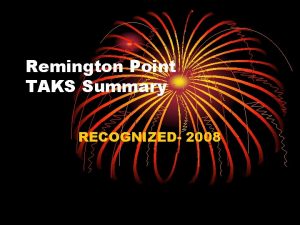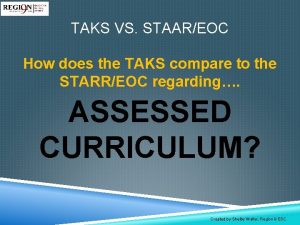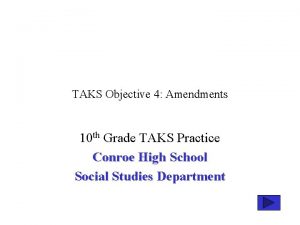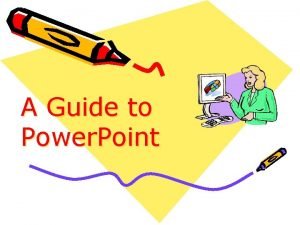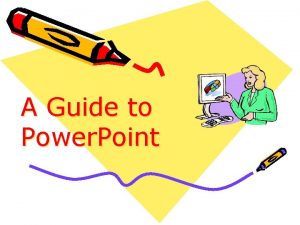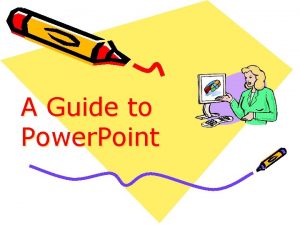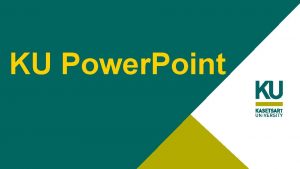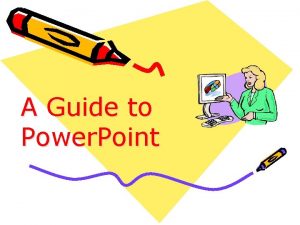U S HISTORY TAKS REVIEW Power Point Presentation






















































































































- Slides: 118

U. S. HISTORY TAKS REVIEW Power. Point Presentation By Mr. Dennis J. Hataway Created 04/12/04

Tammany Hall and Era of Political Machines n Informal organizations that control formal processes of government, created by elected officials to guarantee their power. Friends rewarded with jobs within the government – spoils system n Engaged in bribery, force, and gerrymandering. n

Tammany Hall and Era of Political Machines n Tweed Ring n n Most notorious of the political machines Led by William “Boss” Tweed Used bribes and fraudulent elections to wrest $200 million dollars from New York City. Exposed in 1871.

Growth of Labor Unions n n In the late 1800 s, two out of three working Americans depended on wages instead of selfemployment. Laborers formed unions n n oppose unfair treatment corporations continued to wield more power than labor. c 1900. Labor Day parade, Main Street, Buffalo, N. Y.

Growth of Labor Unions n n National Labor Union (1866) – first union American Federation of Labor (1886) n n n Founded by Samuel Gompers Sought better wages, hours, and general improvement in working conditions. Supported walkouts and boycotts

Growth of Labor Unions n n Public support for labor increased during the latter part of the 19 th century. In 1894, Labor Day was declared a legal holiday by the federal government.

Open Door Policy n In an effort to protect U. S. trade with China, Secretary of State John Hay opposed the increase of British, German, Russian, French, and Japanese trade with China.

Open Door Policy n He wrote letters to the respective governments requesting that they support an Open Door Policy in China (1899 -1900). n n State that all nations would have equal trading rights in China. Most nations abided by the agreement and worked to suppress the Boxer Rebellion in 1900, a Chinese uprising against foreign influences including business and missionary interests.


Progressive Era n Occurred over a period of time between 1890 s and the Great Depression. n n n First called such by Pres. Wilson in 1911 Movement coincided with the rise of big business and increased interest in scientific engineering and organization. Reform movement concentrated in urban areas and in industry.

Progressive Era n Features: n n Decrease in voter participation Increase in special interest groups striving to reform society, the economy, and politics.

Progressive Era n Features: n Commissioner Form of Government n Following the Galveston Hurricane in 1900, people were hired to rebuild the city based on their knowledge of city planning, not because of political connections.

Progressive Era n Features: n n n Drug inspection and labeling began Child labor laws and minimum wage measures were considered Women’s rights gained attention.

Progressive Era n In the early 1900 s a series of political reforms was enacted to improve the efficiency and response of city and state government. These included initiative and referendum which served to give voters a greater role in the lawmaking process and recall which increased a voter’s ability to eject an elected official from office.

Spanish-American War (1898) n Triggered by explosion of the Maine on Feb. 15, 1898, in Havana Harbor.

Spanish-American War (1898) n n On April 11, 1898, Pres. Mc. Kinley asked Congress to authorize armed intervention against Spain to free the oppressed Cubans. The Navy, commanded by Cmdr. George Dewey, sailed into Manila Bay in the Philippines on May 1.

Spanish-American War (1898) n The “Rough Riders, ” led by Theodore Roosevelt, rushed San Juan Hill, Cuba, on July 1

Spanish-American War (1898) n n n American Fleet destroyed Spanish ships in Santiago Harbor, Cuba, on July 3. Disease ravaged U. S. forces; 400 died in battle or due to injuries while more than 5, 000 succumbed to malaria, typhoid, dysentery, and yellow fever. Results: n n Cuban received independence. U. S. acquired Puerto Rico, island of Guam, and the Philippines.

Panama Canal n Hay-Pauncefote Treaty (1901) n Gave the U. S. right to construct and defend a canal through Central America.

Panama Canal Hay-Pauncefote Treaty (1901) n n n Many nations had sought quicker, safer access to the east from the west, and the narrow isthmus of Panama offered a link. Once the 50 -mile long canal was completed in 1914, it changed the world’s systems of transportation, communication, and economics.

16 th and 17 th Amendments n 16 th Amendment n Gave Congress the power to tax income (1913)

16 th and 17 th Amendments n 17 th Amendment n Guaranteed to the direct election of senators by the voters (1913)

World War I: The Great War (1914 -1918) n Triggered when a Serb assassinated Austrian-Hungarian heir Franz Ferdinand.

World War I: The Great War (1914 -1918) n Combatants: n n Central Powers: Germany, Austria. Hungary, Turkey, and Bulgaria. Allied Powers: France, Britain, and Russian and later Japan, Italy, and the United States.

World War I: The Great War (1914 -1918) n n American Trade with Central Powers limited by British control of the shipping channels in the Atlantic. German U-boats sank British passenger liner Lusitania on May 7, 1915, at the cost of 128 American lives.

World War I: The Great War (1914 -1918) n n Germany announced its plan to wage unlimited submarine warfare. Sank four U. S. merchant marine vessels in March.

World War I: The Great War (1914 -1918) n On April 2, 1917, Wilson asked Congress to declare war.

World War I: The Great War (1914 -1918) n American Expeditionary Force sent to Europe under the command of John J. Pershing. n n U. S. troops participated in the last major offensive of the war. Battle of Meuse-Argonne lasted 42 days and involved 1. 2 million U. S. troops.

World War I: The Great War (1914 -1918) n Germany surrendered on Nov. 11, 1918. n n Peace negotiations completed in 1919. U. S. does not join the League of Nations.

Treaty of Versailles n n n Formal agreement ending World War I. Challenge to divide the territory contained in four empires which collapsed at the end of the war: Russia, Austria-Hungary, Ottoman Empire, and Germany. Establishment of the League of Nations Charged Germany with responsibility for the war, requiring war reparations paid to the Allies and stripping it of all colonies. U. S. Senate refused to ratify the treaty.

Teapot Dome Scandal n Worst of many scandals in the Warren G. Harding administration (1921 -1925) n Harding had brought to Washington a group of corrupt friends and political advisors from Ohio.

Teapot Dome Scandal n Teapot Dome, Wyoming n n n A rich oil reserve Harding’s Secretary of the Interior, Albert B. Fall leased reserves to oilmen who paid him kickbacks. Scandal involved other members of the administration Investigations and trials continued for nearly a decade.

Prohibition n 18 th Amendment adopted in 1919 n n In 1919 it became illegal to manufacture, sell, or transport alcoholic beverages. Emerged from the Progressive era’s push for moral, social, and political reform.

Prohibition n 18 th Amendment adopted in 1919 n n n Temperance leagues began working to reduce alcoholism and social problems result from it as early as the 1820 s. The Women’s Christian Temperance Union was founded in 1874. Laws to ban alcohol were adopted in states as early as 1846.

Prohibition n Negative effects n n The ability to sell grapes and barley was reduced and hurt farmers. Enforcement was difficult Gangs made millions of dollars dealing in illegal liquor; crime actually increased. Repealed in 1933. Al Capone, 1930 (National Archives, Still Picture Branch, 306 -NT-163. 820 C )

Great Depression (1929 -1939) n n Pres. Hoover’s efforts to slow the speculation in paper profits through the Federal Reserve Board had little effect. Stocks fluctuated considerably during the fall of 1929.

Great Depression (1929 -1939) n n Erratic sales on “Black Thursday, ” October 24, caused investors concern. October 29, “Black Tuesday, ” over 16 Million shares were sold on the stock exchange.

Great Depression (1929 -1939) n By late 1929, investors lost $40 billion in paper values, an amount greater than total U. S. expenditures for WWI.

Great Depression (1929 -1939) n The stock market collapse preceded a world-wide economic depression. n n By the end of 1930, more than 4 million workers were jobless in the U. S. By 1932, 12 million were unemployed.


New Deal (1933 -1941) n n Pres. Franklin Roosevelt's plan to end the Depression. Funds to pay for New Deal programs came from increasing income taxes on corporations and the rich, and increasing estate and gift taxes.

New Deal (1933 -1941) n n Bills passed during the first 100 days of his presidency in 1933 stressed “the three R’s” of relief, recovery, and reform. Relief programs for the needy n n Civilian Conservation Corps (CCC) Civil Works Administration (CWA)

New Deal (1933 -1941) n Recovery programs n n Home Owners Loan Corporation (HOLC) Agricultural Adjustment Act (AAA) n n n Monitored crop acreage and livestock numbers Set quotas and maintain prices National Recovery Administration (NRA) n Worked with business to manage prices and wages

New Deal (1933 -1941) n Reform Efforts n Federal Deposit Insurance Corporation (FDIC) n n Guaranteed individual deposits Securities and Exchange Commission (SEC) n Required investment firms to provide accurate information on their finances.

New Deal (1933 -1941) n Social Security Act (1935) n n Levied a tax on employers to provide compensation and protection for Americans unable to work. Employees and employers shared contributions to the fund which would provide monthly payment to workers following their retirement.

Time of the Dictators n A dictator is a ruler who wields absolute authority and controls the government within a state or nation. n n Adolf Hitler: Germany Benito Mussolini: Italy Joseph Stalin: Soviet Union Francisco Franco: Spain

Time of the Dictators n The League of Nations did not oppose the actions of dictators n n Nor did nations such as Britain, France, or the United States intercede as the republican government of Spain fell to Franco. This encouraged the dictators as they organized and strengthened their control of Europe.

World War II (1941 -1945) n n Totalitarian dictators were on the rise in Europe throughout the 1930 s as the depression set in. In Japan, the military began to make moves without the direction of the government or the Emperor invading Manchuria (China) in 1931.

World War II (1941 -1945) n Dec. 7, 1941 Japanese attack on Pearl Harbor prompted the U. S. to declare war.

World War II (1941 -1945) n n Germany and Italy responded by declaring war on the U. S. The U. S. entered WWII in 1941 fight a two front war: Europe and Pacific.

World War II (1941 -1945) n n n Nearly 15 million men and 200, 000 women were enlisted. More than 6 million women worked outside the home to help keep the economy going. In 1942 Allied troops invaded North Africa and in 1943 Allied troops invade Italy.

World War II (1941 -1945) n D-Day n n On June 6, 1944, Gen. Dwight Eisenhower led 3 million Allied troops in crosschannel invasion of France, landing at Normandy. Liberated Paris by August.

World War II (1941 -1945) n Battle of the Bulge n Dec. 16, 1944, Adolf Hitler countered with a concentrated attack on American forces in the Ardennes Forest. German advance was stalled and finally repulsed.

World War II (1941 -1945) n n Eisenhower’s troops advanced through Germany, meeting Soviet troops at the Elbe River in April 1945. Pres. Roosevelt died of massive cerebral hemorrhage on April 12, 1945.

World War II (1941 -1945) V-E Day = May 8, 1945

World War II (1941 -1945) n War with Japan continued until August n n Fire bombed Tokyo Mar. 9 -10, 1945 August 6, 1945, first atomic bomb dropped on the military base city of Hiroshima. n n 180, 000 killed or missing August 9, 1945, second bomb fell on the naval-base of Nagasaki n 80, 000 killed or missing

World War II (1941 -1945) n V-J Day n n August 10, 1945 Surrender ceremony occurred on the U. S. S. Missouri anchored in Tokyo Bay on Sept. 2, 1945

G. I. Bill n Servicemen’s Readjustment Act (1944) n n Part of a strategy to avoid economic downturn after WWII. GI Bill allotted funds to send former soldiers to school. n n Enabled 8 mllion veterans to seek vocational and technical training or college degrees. Allowed the Veteran’s Administration to guarantee $16 billion in loans to veterans to purchase homes, farms, or small businesses.

U. S. as a World Power n Factors contribute to rise of U. S. : n n 1880 s industrial revolution allowed the country to compete with Britain for economic dominance. Increasing transportation and ports-of-call in major trading areas. Following WWII, the U. S. surpassed Britain as a world power. The USSR and the USA were considered world powers because their foreign policy impacted world decisions.

Soviet Aggression n In 1922 communists created the Union of Soviet Socialist Republics (USSR or the Soviet Union) Following WWII, communists sought to take over Greece and establish an airbase in Turkey. President Truman managed to persuade Congress that this was a global struggle for freedom over Communism


Soviet Aggression n Police of Containment n n Support “free peoples who are resisting attempted subjugation by armed minorities or by outside pressures. ” Basis for the Truman Doctrine

Soviet Aggression n Marshall Plan n Proposed economic aid to Europe and help generate trade between the United States and European nations.

Soviet Aggression n Berlin Blockade n n 1948 Stalin attempted to eliminate involvement of the west in Berlin. The U. S. flew tons of supplies into Berlin in an operation called the Berlin Airlift.

Soviet Aggression n NATO n n The blockade of Berlin prompted the United States to join Canada, Iceland, and nine other Western European nations in the North Atlantic Treaty Organization (NATO). Each pledged loyalty to the other in case of attack.

Korean War n Korea divided after WWII. n n North Korea occupied by Soviets South Korea occupied by U. S.

Korean War n June 26, 1950 n n Following withdrawal of U. S. and Soviet forces, communist North Korea invaded South Korea United Nations troops, under command of Gen. Douglass Mac. Arthur, order to lead a “peace action” in Korea.

Korean War n Truman vs. Mac. Arthur n n Difference of opinion over application of force resulted in Mac. Arthur being fired. Their conflict mirrored public sentiment n n Some Americans felt we should not be involved Other Americans felt we should intervene in a decisive way to bring an end to the conflict and the expansion of communism.

Korean War n President Eisenhower negotiated peace in 1953 but communism continued as a presence in Asia.

Mc. Carthyism n n Cold War era begins Fear of communism increased throughout the 1950 s as Americans became sensitized to the threat through publicized investigations of critics of the government.

Mc. Carthyism n Joseph Mc. Carthy, a senator from Wisconsin and staunch anticommunist n Worked to identify known communists and accused others based on association.

Mc. Carthyism n Joseph Mc. Carthy n n Many public figures lives were ruined when they were blacklisted. Employers refused to hire those suspected of communist activities because Mc. Carthy’s tactics of guilt by association made the employee suspect.

Mc. Carthyism n Army-Mc. Carthy Hearings n In 1954, televised Senate investigations failed to substantiate his claims of communists collusion and lost favor with the Senate, and the American public.

1957: Year of the Space Race n October 4, 1957 n n n Soviets launched the world’s first space satellite, Sputnik. One month later they launched Sputnik II with a dog on board. American scientists quickly developed a small satellite and launched in early 1958.

1957: Year of the Space Race n National Defense and Education Act (1958) n n Education system fell under scrutiny; fear we were falling behind “backward” Soviet Union. Authorized $887 million for loans and grants to improve science, mathematics, and language education.

Brown v. Board of Education (1954) Outlawed racial segregation in public schools n n in this landmark case. Reversed the 1896 decision, Plessy v. Ferguson, which held that states could segregated public facilities as long as all facilities were equal.

Brown v. Board of Education (1954) n Case was argued by Thurgood Marshall and other NAACP lawyers. n n Proved that separate schools were not equal and never would be because segregation implied inequality. Referenced the 14 th Amendment’s equal protection clause.

Civil Rights Movement (1954 -1968) n n Civil Rights are the legal and political rights enjoyed by Americans, especially the rights guaranteed by the 13 th and 14 th amendments to the U. S. constitution. For nearly 100 years, until the adoption of the Civil Rights Act of 1964, African Americans and women sought equality before the law and protection of their rights.

Civil Rights Movement (1954 -1968) n Beginning in the 1940 s, nonviolent tactics were adopted in an effort to unify protest.

Civil Rights Movement (1954 -1968) n Civil Rights Act of 1964 n n n Signed by President Lyndon Johnson Made racial, religious, and sex discrimination by employers illegal. Gave the federal government power to enforce all laws governing civil rights including the desegregation of schools and public places.

Civil Rights Movement (19541968) n March on Washington (1963) n Important step for the black community in gathering national attention to its plight.

Civil Rights Movement (19541968) n Civil Disobedience n Black activists, often affiliated with church groups, continued to offer passive resistance to the unjust civil laws.

Civil Rights Movement (19541968) n Equal Rights Amendment (1972) n n Accepted by Congress after more than 130 years of effort on the part of women. However, after ten years, twothirds of the state legislatures had not ratified the measure and it died in 1982.

Native American Policies n n Since the arrival of Columbus in North America, Native Americans have faced European diseases, expansion, and competitiveness. Native American were forcibly removed from their ancestral lands, isolated on reservations, and forced to abandon their traditions and rituals.

Native American Policies n Dawes Act (1887) n n n Effort to assimilate the Native Americans. Ended tribal ownership of land, gave heads of families 160 acres of land, granted citizenship after 25 years if they complied. All Native Americans given citizenship in 1924.

Native American Policies n Indian Reorganization Act of 1934 n n Tried to restore the tribal basis of life. American Indian Movement n Following the example of African Americans in their quest for civil rights. In 1973 Indian activists staged a twomonth protest at Wounded Knee, South Dakota, part of a widespread Native American movement in the '70 s in support of treaty rights, Indian sovereignty, and cultural preservation. © Black Star Picture Collection, Inc.

Vietnam Conflict n Freedom Movement n n n Vietnam, a long, narrow country in Southeast Asia, sought to maintain its independence despite centuries of Chinese and French occupation. During WWII, Japan seized the country from the French in 1941. Communist leader Ho Chi Minh organized the independence movement.

Vietnam Conflict n The U. S. supported Ho Chi Minh’s opposition to Japan, but agreed to support Vietnam’s return to French rule following the war.

Vietnam Conflict n French Indochina War (1946 -1954) n n n Divided the country at the 17 th parallel N. Vietnam capital at Hanoi under Minh S. Vietnam capital at Saigon led by Ngo Diem

Vietnam Conflict n n President Eisenhower support Diem from 1954 to 1960, a corrupt politician who manipulated voting and repressed nonconformists. Gulf of Tonkin Resolution n n August 1964, U. S. Navy ships exchanged fire with North Vietnamese Congress passed the Resolution empowering Pres. Lyndon B. Johnson to direct military support to Southeast Asia.

Vietnam Conflict n Deeper Involvement in a Civil War n n After a Viet Cong raid on an American air base, Johnson ordered American troops to land. By 1965, 184, 000 American troops were involved.

Vietnam Conflict n Deeper Involvement in a Civil War n n Foreign policy officials presented the issue as an effort to protect the noncommunist south from the communist north. In reality the confrontation was between supporters of Diem and their opposition, the Viet Cong.

Vietnam Conflict n Decline of American Support n As more American tax dollars and troops were expended on the military offensive, and as the Viet Cong and North Vietnamese countered every escalation with more manpower and guerrilla tactics, public support for the war waned.

Vietnam Conflict n n The Vietnam war continued until January 1973. It was the longest military engagement in U. S. history and the United States’ first defeat.

War Powers Act n n Result of the growing negative sentiment on part of the American public toward the Vietnam War. Congress Passed the War Powers Act on Nov. 7, 1973, following the withdrawal of U. S. troops from Vietnam.

War Powers Act n Required: n n President to inform Congress within two days of any use of American troops in a foreign country Withdraw troops with 60 days if Congress did not support their deployment.

Watergate Scandal n n Result of Nixon bid for reelection Break-in at the Watergate Office Complex in Washington, D. C. n n Began with arrest of five burglars, paid by the Nixon campaign committee They had broken into the Democratic National Committee headquarters

Watergate Scandal n “Cover-up” n Some of Nixon’s staff tried to limit the investigation.

Nixon resigned August 9, 1974 to avoid Watergate Scandal impeachment charges that he: n n n Knowingly obstructed justice Used government agencies to violate the constitutional rights of citizens Illegally withheld evidence from Congress. Nixon Pardoned by Pres. Gerald Ford

The Cold War n Following World War II, the United States and the USSR emerged as superpowers. n n n Arms Race that lasted nearly 50 years. Used diplomacy and nerves to compete for resources, markets, and political strength in a world economy. Bomb shelters

The Cold War n Cuban Missile Crisis (Oct. 1962) n Soviets placed ICBMs in Cuba.

The Cold War n Cuban Missile Crisis (Oct. 1962) n n Pres. Kennedy warned Soviet leader Nikita Khrushchev that an attack launched from Cuba on the U. S. would be considered an attack from the Soviet Union. Resulted in the nuclear test-ban treaty of 1963 and a direct communications line between Moscow and Washington, D. C.

The Cold War n SALT Agreement (1972) n Pres. Nixon strove to slow the arms race through the Strategic Arms Limitations Talks

The Cold War n Strategic Defense Initiative (1983) n n n Derisively called the “Star Wars” program Pres. Reagan’s proposal to establish a missile defense system. A strategy based in advanced technology aimed at outpacing the Soviet defense.

The Cold War n By the late 1980 s the United States and the Soviet Union combined deployed more than 16, 000 nuclear warheads.

The Cold War n Fall of Communism n Combination of factors including the rise of pro-democracy movements in eastern Europe and China and the overthrow of communist governments in Poland, Hungary, Czechoslovakia, and Romania thawed the Cold War.

The Cold War n Fall of Communism n 1989 n n The Berlin Wall came tumbling down. The Two Germanys were reunited in October 1990 after 45 years of political and military separation.


The Cold War n Fall of Communism (cont. ) n The USSR dissolved during the tenure of Mikhail Gorbachev as his policies of glasnost and perestroika worked to undermine communism.


The Cold War n Fall of Communism (cont. ) n Replacing the USSR, the Commonwealth of Independent States developed, 15 new governments which adopted freemarket economies.

The Cold War n Fall of Communism (cont. ) n Forty years of American foreign policy had to be reassessed n n to cope with the new realities as former Soviet nations struggled with adopted western-style capitalism and politics; western European nations were forced to develop strategies to cope with refugees and challenges to their stable economies posed by their weaker neighbors in Eastern Europe.

n On the sunny morning of September 11, 2001, 19 terrorists, working in teams of 4 or 5, hijacked four commercial jetliners and turned them toward targets chosen for destruction.

September 11, 2001 Terrorist Attack on the United States n Two of the planes, loaded with fuel and passengers, were flown at full speed into the twin towers of the World Trade Center in the financial district of New York City.

September 11, 2001 Terrorist Attack on the United States n A third terrorist crew smashed their plane into the Pentagon, headquarters of the U. S. military in Arlington, Virginia.

September 11, 2001 Terrorist Attack on the United States n The hijackers of the fourth airliner apparently intended to hit another target in the Washington, D. C. , area, but passengers on the plane realized what was happening and fought back crashing the airplane in a field in rural Pennsylvania.

September 11, 2001 Terrorist Attack on the United States n The coordinated terrorist strike on the United States killed nearly 3, 000 people and shook the nation to its core.

End of Slide Show
 Moore finance taks
Moore finance taks Hindi presentation topics
Hindi presentation topics Power point presentation design west vancouver
Power point presentation design west vancouver Real power and reactive power
Real power and reactive power Powerbi in powerpoint
Powerbi in powerpoint Point point power
Point point power Smallest anteroposterior diameter of the pelvic inlet
Smallest anteroposterior diameter of the pelvic inlet Cephalic presentation
Cephalic presentation Quarterly business review presentation
Quarterly business review presentation Movie review presentation
Movie review presentation Awareness iso 9001
Awareness iso 9001 Design review presentation
Design review presentation Test readiness review
Test readiness review Chapter review motion part a vocabulary review answer key
Chapter review motion part a vocabulary review answer key Writ of certiorari ap gov example
Writ of certiorari ap gov example Narrative review vs systematic review
Narrative review vs systematic review Inclusion criteria examples
Inclusion criteria examples Narrative review vs systematic review
Narrative review vs systematic review History of london presentation
History of london presentation Identify hazards
Identify hazards World history spring final exam review answers
World history spring final exam review answers Florida us history eoc review
Florida us history eoc review Us history regents review
Us history regents review Us history eoc review notebook
Us history eoc review notebook 11 grade us history eoc review
11 grade us history eoc review Cold war kahoot
Cold war kahoot World history 1 sol review packet
World history 1 sol review packet World history semester 2 final review packet
World history semester 2 final review packet World history semester 2 final exam review
World history semester 2 final exam review Section 18-1 review history of taxonomy
Section 18-1 review history of taxonomy Ap world history 600 to 1450 review
Ap world history 600 to 1450 review U.s. history semester 2 final exam
U.s. history semester 2 final exam Us history regents practice
Us history regents practice Plato believed in rule by ______.
Plato believed in rule by ______. U.s. history semester 1 final exam
U.s. history semester 1 final exam Day 1 us history eoc review
Day 1 us history eoc review Day 1 us history eoc review
Day 1 us history eoc review Chemistry fall semester exam review answers
Chemistry fall semester exam review answers World history 1st semester final review answers
World history 1st semester final review answers History sol review
History sol review Unit 1 test review us history
Unit 1 test review us history Ap world history jeopardy review game
Ap world history jeopardy review game World history final exam review
World history final exam review Oldcarts
Oldcarts What is the main idea of the cartoon?
What is the main idea of the cartoon? 8 contemporary court
8 contemporary court Systematic review in history taking
Systematic review in history taking This area along the german/belgian border was demilitarized
This area along the german/belgian border was demilitarized Differentiate power series
Differentiate power series Point of view presentation
Point of view presentation The starting point in a presentation
The starting point in a presentation Story elements test
Story elements test Point of view review
Point of view review Also history physical
Also history physical Solar power satellites and microwave power transmission
Solar power satellites and microwave power transmission Potential power
Potential power Flex power power supply
Flex power power supply Dispersive power of a grating is
Dispersive power of a grating is Power of a power property
Power of a power property General power rule
General power rule Power angle curve in power system stability
Power angle curve in power system stability Power absorbed or delivered
Power absorbed or delivered Neolithic revolution turning point
Neolithic revolution turning point Evangelio del domingo en power point
Evangelio del domingo en power point Ejemplos de ova en power point
Ejemplos de ova en power point La boutique del powerpointx
La boutique del powerpointx Il mio sport preferito in francese
Il mio sport preferito in francese Power point turing complete
Power point turing complete Power point sul riciclo in inglese
Power point sul riciclo in inglese Gambar blok dienes
Gambar blok dienes Sekolah sabat dewasa
Sekolah sabat dewasa Laboutiquedelpowerpoint x
Laboutiquedelpowerpoint x La boutique del power point
La boutique del power point La boutique del power point
La boutique del power point La boutique del powerpoint
La boutique del powerpoint Animasi terima kasih power point bergerak
Animasi terima kasih power point bergerak Decreto 1330 del 25 de julio de 2019
Decreto 1330 del 25 de julio de 2019 Powerpoint
Powerpoint Portafolio digital estudiantil ejemplo
Portafolio digital estudiantil ejemplo Cara mengoperasikan microsoft powerpoint 2010
Cara mengoperasikan microsoft powerpoint 2010 Formula potencia electrica
Formula potencia electrica Advantages of power point
Advantages of power point Ventajas y desventajas de powerpoint
Ventajas y desventajas de powerpoint Tesina power point
Tesina power point La boutique del powerpoint
La boutique del powerpoint Ppt penyusunan rpp
Ppt penyusunan rpp Power point fisica
Power point fisica Power point
Power point Concentrese en power point
Concentrese en power point Modelos de bosquejo
Modelos de bosquejo Arte egizia riassunto ppt
Arte egizia riassunto ppt La boutique del powerpoint pps
La boutique del powerpoint pps La boutique del powerpoints
La boutique del powerpoints La boutique del powerpoint x
La boutique del powerpoint x Power point
Power point La boutique del powerpoint
La boutique del powerpoint Apocalipsis el numero de la bestia
Apocalipsis el numero de la bestia Krtki
Krtki Repetition rhetorical definition
Repetition rhetorical definition Estudios para evangelizar
Estudios para evangelizar Ventajas y desventajas de usar power point
Ventajas y desventajas de usar power point Power point
Power point Www.laboutiquedelpowerpoint.com
Www.laboutiquedelpowerpoint.com Power point 2002
Power point 2002 Komunikacja interpersonalna prezentacja power point
Komunikacja interpersonalna prezentacja power point Plantillas de powerpoint
Plantillas de powerpoint Grundvandspejling
Grundvandspejling Power point ethernet
Power point ethernet Power point links
Power point links Caracteristicas de mac os
Caracteristicas de mac os Presentazione power point tesi unipd psicologia
Presentazione power point tesi unipd psicologia Intervalos automáticos o manuales de powerpoint
Intervalos automáticos o manuales de powerpoint Intervalos automáticos o manuales
Intervalos automáticos o manuales Power point temple
Power point temple Power point links
Power point links Power point
Power point Power point tesis doctoral medicina
Power point tesis doctoral medicina Power point rembuk stunting
Power point rembuk stunting Rangkuman modul 3 pembelajaran terpadu di sd
Rangkuman modul 3 pembelajaran terpadu di sd
